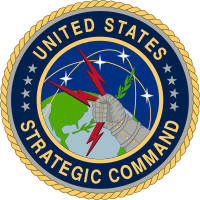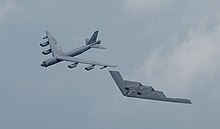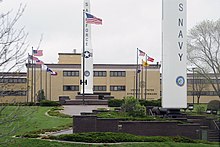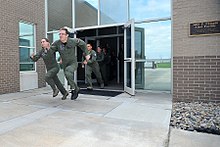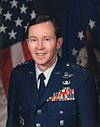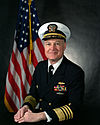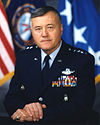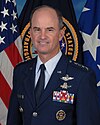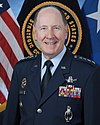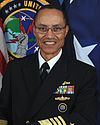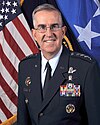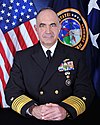
The United States Air Force (USAF) is the air service branch of the United States Armed Forces, and is one of the eight uniformed services of the United States. Originally created on 1 August 1907, as a part of the United States Army Signal Corps, the USAF was established as a separate branch of the United States Armed Forces in 1947 with the enactment of the National Security Act of 1947. It is the second youngest branch of the United States Armed Forces and the fourth in order of precedence. The United States Air Force articulates its core missions as air supremacy, global integrated intelligence, surveillance and reconnaissance, rapid global mobility, global strike, and command and control.
The United States Armed Forces are the military forces of the United States. The armed forces consist of six service branches: the Army, Marine Corps, Navy, Air Force, Space Force, and Coast Guard. All six armed services are among the eight uniformed services of the United States.
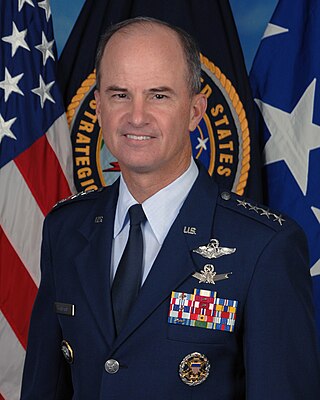
Kevin Patrick "Chilli" Chilton is an American mechanical engineer and retired United States Air Force four-star general, test pilot, and NASA astronaut. His last assignment was as commander of U.S. Strategic Command from October 3, 2007, to January 28, 2011. Prior to his appointment to general officer ranks, Chilton spent 11 years of his military career as a NASA astronaut. He retired from the Air Force on February 1, 2011, after having achieved the highest rank of any military astronaut. On January 30, 2012, General Chilton was named to the board of directors of Orbital Sciences Corporation.

The United States Space Command is a unified combatant command of the United States Department of Defense, responsible for military operations in outer space, specifically all operations 100 kilometers and greater above mean sea level. U.S. Space Command is responsible for the operational employment of space forces that are provided by the uniformed services of the Department of Defense.

NetOps is defined as the operational framework consisting of three essential tasks, Situational Awareness (SA), and Command & Control (C2) that the Commander (CDR) of US Strategic Command (USSTRATCOM), in coordination with DoD and Global NetOps Community, employs to operate, manage and defend the Global Information Grid (GIG) to ensure information superiority for the United States.
Joint Task Force-Global Network Operations (JTF-GNO) was a subordinate command of United States Strategic Command whose mission was to: direct the operation and defense of the Global Information Grid (GIG) across strategic, operational, and tactical boundaries in support of the US Department of Defense's full spectrum of war fighting, intelligence, and business operations.

Joint Functional Component Command for Integrated Missile Defense is a component of United States Space Command (USSPACECOM). The current commander is Army Lieutenant General Daniel L. Karbler.
The Joint Functional Component Command for Intelligence, Surveillance and Reconnaissance was a subordinate command of the United States Strategic Command, one of the nine Unified Combatant Commands under the United States Department of Defense (DOD) and co-located with the Defense Intelligence Agency (DIA). It served as the center for planning, execution, and assessment of the United States military's global Intelligence, Surveillance, and Reconnaissance operations from 2005-2016; a key enabler in achieving global situational awareness. In 2016 JFCC-ISR was realigned to the Joint Staff.
The Joint Functional Component Command for Global Strike (JFCC-GS) was a component of US Strategic Command (USSTRATCOM). It was established on 19 July 2006 when the Joint Functional Component for Space and Global Strike stood down. Its first commander was Lieutenant General Robert J. "Bob" Elder Jr., who simultaneously served as the commander of the 8th Air Force. JFCC-GS was inactivated on October 2, 2017 as part of USSTRATCOM's effort to reorganize its components into a more streamlined war fighting structure.

The 625th Strategic Operations Squadron (STOS) is a United States Air Force nuclear missile control & support squadron. The 625th STOS has five flights that play different roles in this mission. The Latin motto of the 625th STOS is Si vis pacem para bellum, which means, "If you wish for peace, prepare for war."

The Operational Test and Evaluation Force (OPTEVFOR) is an independent and objective agency within the United States Navy for the operational testing and evaluation (OT&E) of naval aviation, surface warfare, submarine warfare, C4I, cryptologic, and space systems in support Navy and Department of Defense acquisition programs.

The Air Force Global Strike Command (AFGSC) is a Major Command (MAJCOM) of the United States Air Force, headquartered at Barksdale Air Force Base, Louisiana. AFGSC provides combat-ready forces to conduct strategic nuclear deterrence and global strike operations in support of combatant commanders. Air Force Global Strike Command is the Air Force's service component to the United States Strategic Command (USSTRATCOM).

The U.S. Marine Corps Forces Cyberspace Command is a functional formation of the United States Marine Corps to protect critical infrastructure from cyberattack. Marine Corps Forces Cyberspace Command is the Marine Corps component to U.S. Cyber Command. It comprises a command element, the Marine Corps Cyber Operations Group, and the Marine Corps Cyber Warfare Group, a total of approximately 800 personnel. MARFORCYBER was established on January 21, 2010 under the command of LtGen George J. Flynn,. As of 7 July 2021, MajGen Ryan P. Heritage is in command.

The Omaha Trophy, which is sponsored by the United States Strategic Command (STRATCOM) and the STRATCOM Consultation Committee, is awarded each year to U.S. military units with intercontinental ballistic missiles, strategic aircraft, strategic space and information operations, as well as to the best ballistic missile submarine. The trophy is currently presented in four official categories:
Joint Elimination Coordination Element (JECE) is a staff element of United States Strategic Command (USSTRATCOM) with the mission of integrating WMD Elimination doctrine into operational plans and joint doctrine, augmenting an existing headquarters to provide elimination planning and command and control expertise, and forming the core of a Joint Task Force for Elimination of WMD (JTF-E).
Joint Functional Component Command for Space and Global Strike was a component of the United States Strategic Command. It was headquartered at Offutt Air Force Base, Nebraska. The Commander, JFCC SGS was dual hatted as the Commander, Eighth Air Force and Commander, JFCC SGS. On 19 July 2006, JFCC SGS was reorganized into two separate JFCCs: Joint Functional Component Command for Global Strike and Integration and Joint Functional Component Command for Space.

The U.S. Fleet Cyber Command is an operating force of the United States Navy responsible for the Navy's information network operations, offensive and defensive cyber operations, space operations and signals intelligence. It was created in January 2010 "to deter and defeat aggression and to ensure freedom of action to achieve military objectives in and through cyberspace". U.S. Tenth Fleet was simultaneously reactivated as its force provider. Since it was founded, the command has grown into an operational force composed of more than 16,000 active and reserve sailors and civilians organized into 27 active commands, 40 Cyber Mission Force units, and 27 reserve commands around the world.

Space Operations Command (SpOC) is the United States Space Force's space operations, cyber operations, and intelligence field command. Headquartered at Peterson Space Force Base, Colorado, it consists of its mission deltas, and garrison commands.
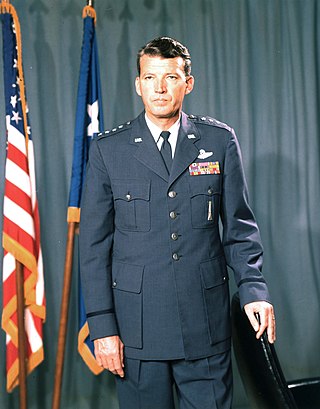
While the United States Space Force gained its independence on 20 December 2019, the history of the United States Space Force can be traced back to the beginnings of the military space program following the conclusion of the Second World War in 1945. Early military space development was begun within the United States Army Air Forces by General Henry H. Arnold, who identified space as a crucial military arena decades before the first spaceflight. Gaining its independence from the Army on 18 September 1947, the United States Air Force began development of military space and ballistic missile programs, while also competing with the United States Army and United States Navy for the space mission.
Global Thunder is an annual U.S. nuclear strategic command and control exercise that is designed to train U.S. Strategic Command forces and assess joint operational readiness. This large-scale training exercise has a primary focus on nuclear readiness and creating conditions for strategic deterrence against a variety of threats. Global Thunder encompasses all missions, including strategic deterrence, space operations, cyberspace operations, joint electronic warfare, global strike, missile defense and intelligence, and lasts for approximately 10 days. Global Thunder is meant to create realistic training activities against simulated opposition, with the goal to improve and maintain nuclear readiness and strategic deterrent capabilities. This training involves increased bomber flights, missileer training, and SSBN readiness, verifying reliability and resilience of the nuclear triad.
